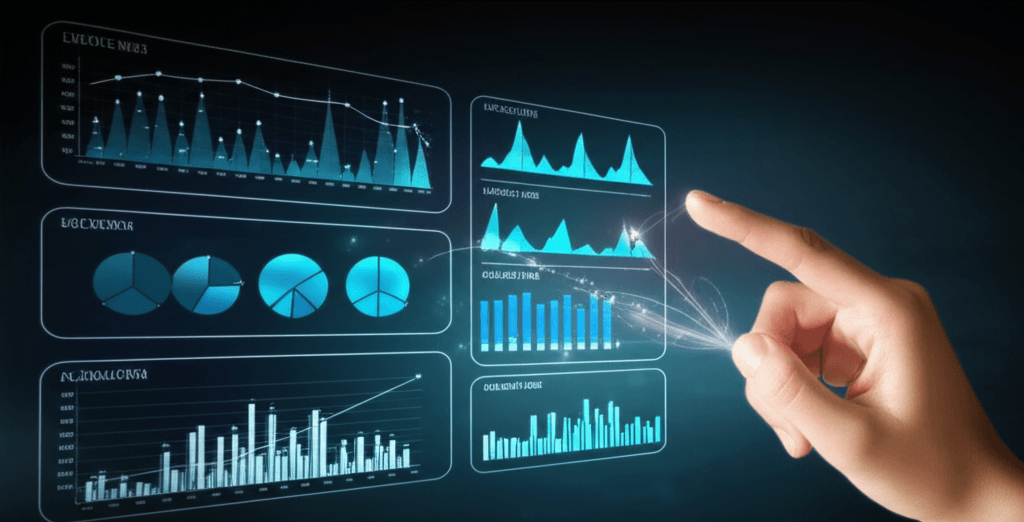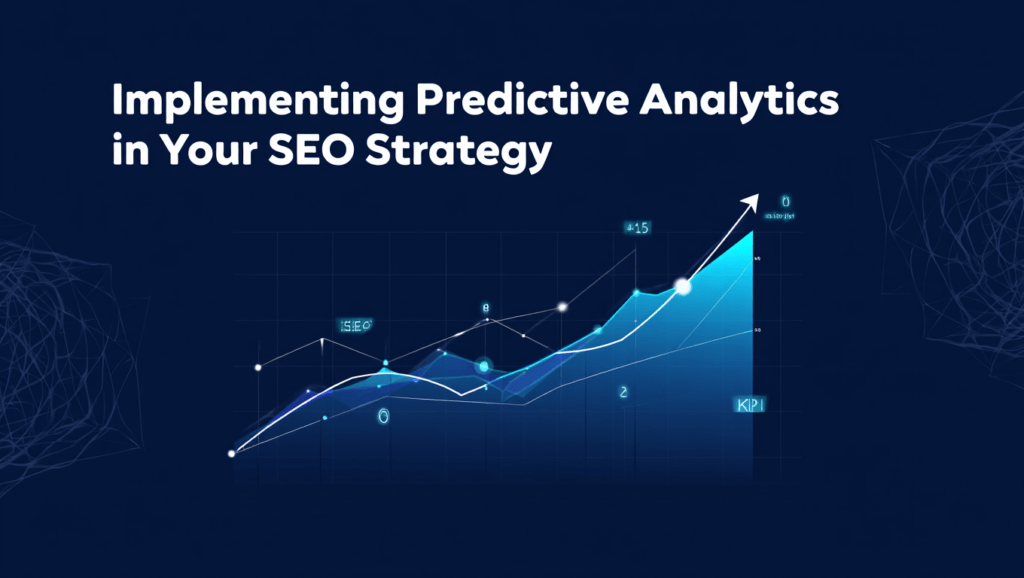The digital landscape is in constant flux, with search engine algorithms evolving, user behavior shifting, and new content emerging at an unprecedented rate. For SEO professionals, staying ahead of the curve has always been paramount.
In 2025, a powerful new ally is emerging to navigate this complexity: AI-powered predictive analytics. By harnessing the ability of Artificial Intelligence to analyze vast datasets, SEO is entering an era where forecasting potential ranking changes, identifying future trends, and understanding shifts in user search intent are becoming increasingly accurate and actionable.
This blog post delves into the transformative power of predictive analytics in SEO, exploring its capabilities, benefits, and the data driving this exciting evolution.
The Limitations of Reactive SEO
Traditional SEO often operates reactively. We analyze past performance, identify what worked (or didn’t), and adjust our strategies accordingly. While this approach remains valuable, it’s akin to driving by only looking in the rearview mirror. We can see where we’ve been, but anticipating the road ahead – the sudden turns, the traffic jams, the changes in speed limits – remains a challenge.
This reactive stance often leaves SEO professionals playing catch-up:
- Ranking Drops: We might notice a sudden dip in rankings and then scramble to diagnose the cause, potentially losing valuable traffic in the interim.
- Missed Opportunities: Emerging trends and shifts in user intent can go unnoticed until they are well-established, allowing competitors to gain an early advantage.
- Wasted Resources: Investing time and effort in strategies that are already losing effectiveness can lead to a significant waste of resources.
Predictive analytics offers a proactive solution, providing a forward-looking perspective that empowers SEOs to make more informed and strategic decisions.
The Power of Predictive Analytics in SEO
Predictive analytics in SEO leverages AI algorithms to analyze historical and real-time data, identify patterns, and generate forecasts about future SEO performance. This capability unlocks a range of powerful applications:
Forecasting Potential Ranking Changes:

Imagine being able to anticipate which keywords your website is likely to gain or lose rankings for in the coming weeks or months. Predictive models analyze a multitude of factors, including:
- Historical Ranking Data: Tracking your website’s past performance for specific keywords.
- Algorithm Updates: Analyzing the impact of past algorithm updates and predicting the potential effects of future changes (based on patterns and announcements).
- Competitor Activity: Monitoring competitor ranking fluctuations, content updates, and backlink profiles.
- Seasonality and Trends: Identifying cyclical patterns in search volume and ranking fluctuations.
- On-Page and Off-Page Factors: Assessing the health and strength of your website’s optimization efforts.
By processing this data, AI algorithms can identify correlations and predict potential ranking shifts, allowing you to proactively address potential issues (e.g., content decay, increased competition) or capitalize on emerging opportunities.
Data Table Example: Keyword Ranking Forecast
| Keyword | Current Rank | Predicted Rank (Next Month) | Confidence Level | Actionable Insights |
| “best running shoes” | 12 | 8 | High | Continue current optimization efforts. |
| “cheap flights to bali” | 5 | 9 | Medium | Analyze competitor content; update and refresh existing page. |
| “organic gardening tips” | 25 | 32 | High | Identify content gaps; create new, comprehensive guide. |
Identifying Future Trends:

Predictive analytics can go beyond individual keyword rankings and identify broader trends that will impact your SEO strategy. This includes:
- Emerging Keyword Opportunities: Analyzing search query data to detect keywords that are gaining traction and represent potential new content opportunities.
- Shifting Content Formats: Identifying changes in the types of content that are performing well for specific queries (e.g., a shift from blog posts to videos or interactive content).
- Evolving User Behavior: Analyzing click-through rates, dwell time, and other engagement metrics to understand how user preferences are changing.
- New Platform Adoption: Predicting the growth and SEO implications of emerging search platforms and technologies.
By identifying these future trends early, businesses can proactively adapt their content strategy, target new keywords, and optimize for emerging platforms, gaining a significant competitive advantage.
Data Table Example: Emerging Keyword Trends
| Trend Category | Emerging Keywords | Predicted Growth (Next Quarter) | Potential Content Ideas |
| Sustainable Living | “zero waste travel kit” | 45% | Blog post: “The Ultimate Guide to Zero Waste Travel”; Product category page. |
| Remote Work | “best standing desk converter” | 30% | Comparison article; video review. |
| AI in Marketing | “AI powered content tools” | 60% | In-depth review of top tools; webinar. |
Understanding Shifts in User Search Intent:

Perhaps one of the most powerful applications of predictive analytics in SEO is its ability to understand and forecast changes in user search intent. This involves analyzing:
- Search Query Refinements: Tracking how users modify their search queries to find the information they need.
- Clickstream Data: Analyzing the pages users click on and how they interact with search results.
- Natural Language Processing (NLP): Understanding the semantic meaning behind search queries and identifying evolving user needs.
- Sentiment Analysis: Gauging the emotional tone and underlying intent behind search queries.
By understanding these shifts, SEO professionals can create content that aligns precisely with user needs at the right time, leading to higher engagement, better conversion rates, and improved rankings. For example, a keyword that once indicated informational intent might evolve to have a stronger transactional intent, requiring a shift in the type of content needed to satisfy searchers.
Data Table Example: Shifts in User Search Intent
| Keyword | Previous Dominant Intent | Predicted Dominant Intent (Next 6 Months) | Implications for Content Strategy |
| “best coffee maker” | Informational (reviews) | Transactional (product comparisons) | Create detailed product comparison pages with clear calls to action. |
| “healthy recipes” | Informational (general) | Navigational (recipes for specific diets) | Segment content by dietary restrictions (vegan, gluten-free, etc.). |
| “customer service software” | Research | Consideration (pricing and features) | Develop detailed pricing pages and feature comparison charts. |
The Data Powering Predictive SEO
The accuracy and effectiveness of predictive analytics in SEO hinge on the quality and volume of data analyzed. Key data sources include:
- Search Engine Results Pages (SERP) Data: Historical ranking data, featured snippets, People Also Ask boxes, and other SERP elements.
- Website Analytics (Google Analytics, etc.): Traffic data, user behavior metrics (bounce rate, dwell time, pages per session), conversion rates.
- Search Console Data: Keyword impressions, clicks, average position, crawl errors.
- Keyword Research Tools Data: Search volume trends, keyword difficulty, related keywords.
- Social Media Data: Mentions, trends, and sentiment related to your brand and industry.
- Economic and Societal Data: Broader trends that might influence search behavior.
- Competitor Data: Ranking history, content updates, backlink profiles.
AI algorithms process this massive influx of structured and unstructured data, identifying complex patterns and correlations that would be impossible for humans to discern manually. Machine learning models continuously learn and refine their predictions as new data becomes available, leading to increasingly accurate forecasts over time.
Implementing Predictive Analytics in Your SEO Strategy

While the underlying technology is complex, the application of predictive analytics in SEO can be integrated into your strategy in several ways:
- Leveraging AI-Powered SEO Tools: Many modern SEO platforms are already incorporating predictive analytics features, providing insights and recommendations directly within their dashboards.
- Integrating with Data Analytics Platforms: Connecting your SEO data with broader data analytics platforms allows for more sophisticated modeling and forecasting.
- Working with Data Scientists: For organizations with significant data resources, collaborating with data scientists can lead to the development of custom predictive models tailored to specific business needs.
- Focusing on Data-Driven Decision Making: Even without advanced tools, understanding the principles of predictive analytics encourages a more data-driven approach to SEO strategy, prioritizing decisions based on trends and forecasts rather than gut feeling.
The Future is Predictive
Predictive analytics is not just a fleeting trend in SEO; it represents a fundamental shift in how we approach search engine optimization. By moving beyond reactive analysis and embracing the power of AI-driven forecasting, SEO professionals can:
- Gain a significant competitive advantage.
- Optimize resource allocation and maximize ROI.
- Proactively adapt to the ever-changing search landscape.
- Deliver more effective and future-proof SEO strategies.
As AI continues to evolve and data availability expands, the capabilities of predictive analytics in SEO will only become more sophisticated and essential. Embracing this future-oriented approach is crucial for any business looking to thrive in the dynamic world of online search. The rearview mirror still offers valuable lessons, but in the fast lane of digital marketing, the ability to predict the road ahead is the key to long-term success.
What is the primary limitation of traditional SEO, and how does predictive analytics address it?
Traditional SEO often operates reactively, analyzing past performance to adjust strategies. This is likened to “driving by only looking in the rearview mirror.” Predictive analytics offers a proactive solution by providing a forward-looking perspective, using AI to forecast future SEO performance and allow for more informed decisions.
Name three specific applications of predictive analytics in SEO.
Predictive analytics in SEO can be used for:
- Forecasting Potential Ranking Changes
- Identifying Future Trends
- Understanding Shifts in User Search Intent
What factors do predictive models analyze to forecast potential keyword ranking changes?
Predictive models analyze a multitude of factors, including historical ranking data, algorithm updates, competitor activity, seasonality and trends, and on-page and off-page factors.
How can predictive analytics help identify emerging keyword opportunities?
By analyzing search query data, predictive analytics can detect keywords that are gaining traction, representing potential new content opportunities for businesses.
What is one of the most powerful applications of predictive analytics in SEO, and what data does it analyze to achieve this?
One of the most powerful applications is understanding shifts in user search intent. This involves analyzing search query refinements, clickstream data, Natural Language Processing (NLP) to understand semantic meaning, and sentiment analysis.
What are the key data sources that power the accuracy and effectiveness of predictive analytics in SEO?
Key data sources include Search Engine Results Pages (SERP) Data, Website Analytics (e.g., Google Analytics), Search Console Data, Keyword Research Tools Data, Social Media Data, Economic and Societal Data, and Competitor Data.
How do AI algorithms contribute to the accuracy of predictive analytics over time?
AI algorithms process massive amounts of structured and unstructured data, identifying complex patterns and correlations. Machine learning models continuously learn and refine their predictions as new data becomes available, leading to increasingly accurate forecasts.
Describe two ways a business can implement predictive analytics into its SEO strategy.
Businesses can implement predictive analytics by leveraging AI-powered SEO tools that incorporate these features, or by integrating their SEO data with broader data analytics platforms for more sophisticated modeling. I recommend a Book SEO/AI Automation Step-by-Step Use Cases, to find ready-to-use workflow.

